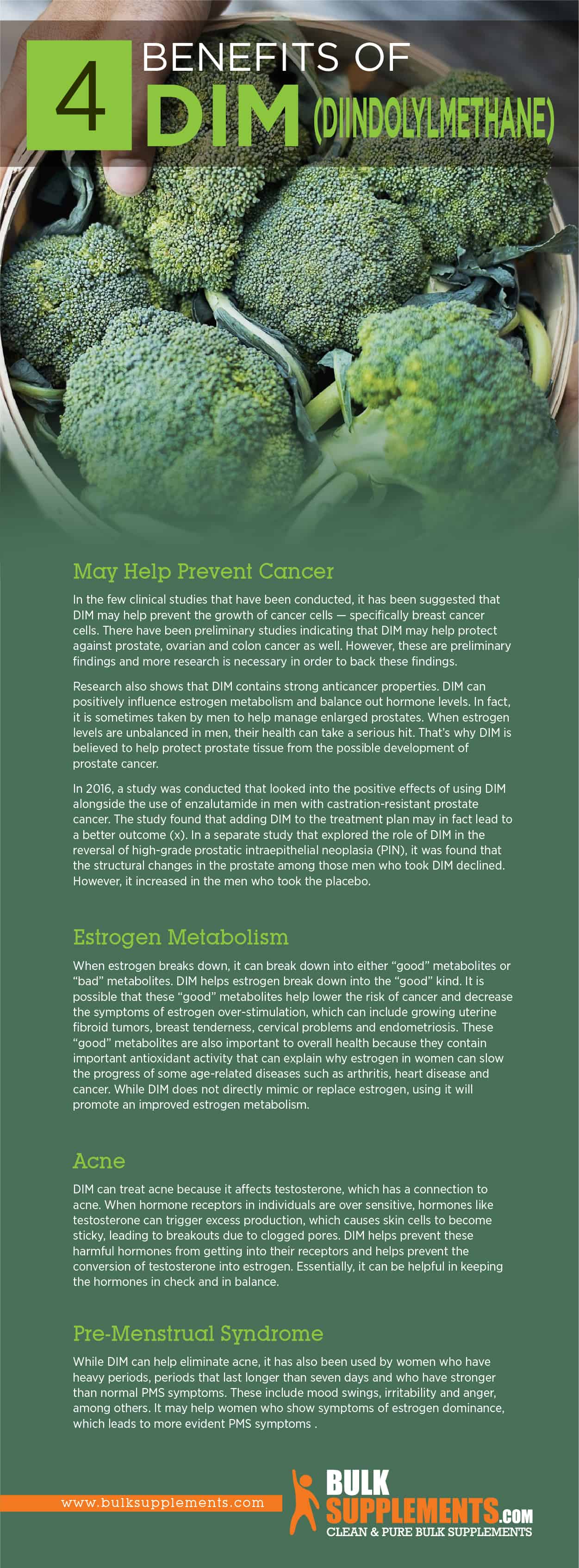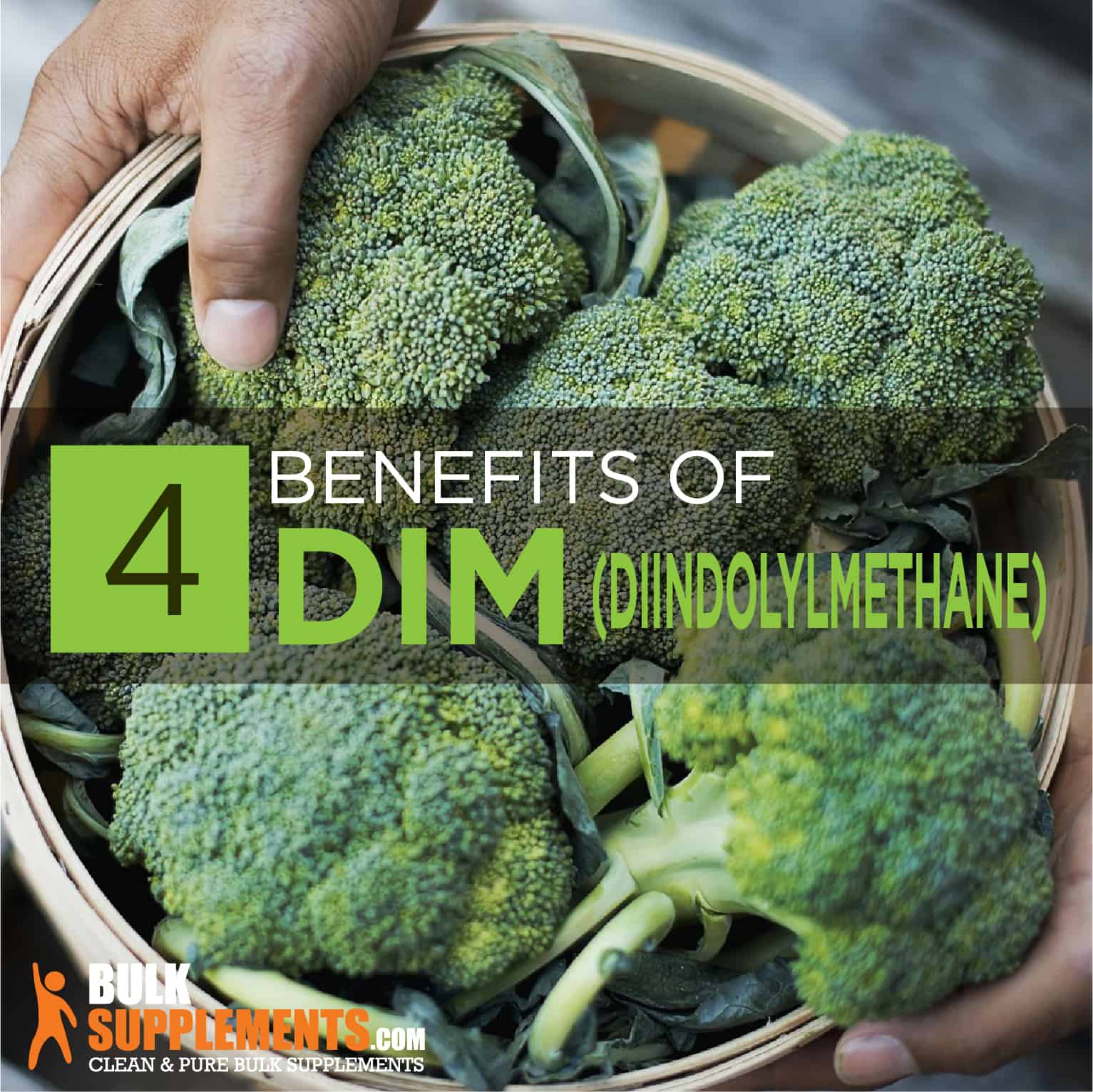What is Diindolylmethane?
We all know that vegetables are good for us and for our overall health. But did you know that diindolylmethane (also known as DIM) is one of the reasons the Brassica family of vegetables is considered so healthy (x)? DIM is a metabolite of indole-3-carbinol (13C), which is a compound present in cruciferous vegetables such as broccoli, cauliflower and cabbage. Each of these vegetables belong to the Brassica family (x). Metabolites are famously useful for supporting the liver detoxification process. This ultimately helps improve the process of breaking down estrogen (x). DIM is the most studied of all 13C metabolites and is being studied as a chemo-protective compound for certain types of cancer (x).
Diindolylmethane Benefits
May Help Prevent Cancer
In the few clinical studies that have been conducted, it has been suggested that DIM may help prevent the growth of cancer cells — specifically breast cancer cells. There have been preliminary studies indicating that DIM may help protect against prostate, ovarian and colon cancer as well. However, these are preliminary findings and more research is necessary in order to back these findings.
Research also shows that DIM contains strong anticancer properties (x). DIM can positively influence estrogen metabolism and balance out hormone levels. In fact, it is sometimes taken by men to help manage enlarged prostates. When estrogen levels are unbalanced in men, their health can take a serious hit. That’s why DIM is believed to help protect prostate tissue from the possible development of prostate cancer.
In 2016, a study was conducted that looked into the positive effects of using DIM alongside the use of enzalutamide in men with castration-resistant prostate cancer. The study found that adding DIM to the treatment plan may in fact lead to a better outcome (x). In a separate study that explored the role of DIM in the reversal of high-grade prostatic intraepithelial neoplasia (PIN), it was found that the structural changes in the prostate among those men who took DIM declined. However, it increased in the men who took the placebo (x).
Some data suggests that taking DIM supplements may slow the development of cervical cancer. Unfortunately, a study published in 2012 failed to show any significant benefit on cervical cell changes among the 551 women who participated (x).
It is too soon to tell whether DIM may significantly fight these forms of cancer because there has been a lack of research conducted. However, signs are encouraging.
Estrogen Metabolism
When estrogen breaks down, it can break down into either “good” metabolites or “bad” metabolites. DIM helps estrogen break down into the “good” kind. It is possible that these “good” metabolites help lower the risk of cancer and decrease the symptoms of estrogen over-stimulation, which can include growing uterine fibroid tumors, breast tenderness, cervical problems and endometriosis (x). These “good” metabolites are also important to overall health because they contain important antioxidant activity that can explain why estrogen in women can slow the progress of some age-related diseases such as arthritis, heart disease and cancer (x). While DIM does not directly mimic or replace estrogen, using it will promote an improved estrogen metabolism.
Acne
DIM can treat acne because it affects male hormones, which has a connection to acne. When hormone receptors in individuals are over sensitive, hormones like male hormones can trigger excess production, which causes skin cells to become sticky, leading to breakouts due to clogged pores (x). DIM helps prevent these harmful hormones from getting into their receptors and helps prevent the conversion of male hormones into estrogen. Essentially, it can be helpful in keeping the hormones in check and in balance.
Pre-Menstrual Syndrome
While DIM can help eliminate acne, it has also been used by women who have heavy periods, periods that last longer than seven days and who have stronger than normal PMS symptoms. These include mood swings, irritability and anger, among others. It may help women who show symptoms of estrogen dominance, which leads to more evident PMS symptoms (x).
Click here to purchase DIM (diindolylmethane) powder now

Food Sources of Diindolylmethane
DIM is a natural substance that is generated when the body breaks down indole-3-carbinol, which is found in certain vegetables, mainly those that are related to the cabbage family. You can get your natural intake of diindolylmethane if you include these healthy foods in your diet (x):
- Broccoli (half cup, chopped): 27 mg per 44 g (x)
- Red Cabbage (half cup, chopped): 29 mg per 45 g (x)
- Cauliflower (half cup, chopped): 22 mg per 50 g (x)
Diindolylmethane Side Effects
When taken correctly in the small amounts found in foods, diindolymethane is likely safe. Diindolylmethane may cause a decrease in the amount of sodium in the body (x).
Some common side effects that occur following the usage of DIM include a rash with eosinophilia as well as central serous chorioretinopathy (x).
Talk with your doctor before taking diindolylmethane supplements if you are pregnant, breast-feeding and if you have hormone-sensitive conditions such as breast cancer, uterine cancer, ovarian cancer, endometriosis or uterine fibroids.
Since diindolylmethane sometimes acts like estrogen, individuals with hormone-sensitive conditions should be careful before adding the supplement to their diet over the concern that it might make hormone-sensitive conditions worse.
Diindolylmethane Dosage
The correct dosage of DIM varies for every person and is dependent on several different factors. A person’s age, health history and other conditions will determine the appropriate dosage. However, it’s best to take about 100 mg (1/16 tsp) or 200 mg (scant 1/8 tsp) once or twice daily. This, of course, depends on the intended effect.
Always consult your doctor before adding any supplement to your diet and remember to read directions on product labels before use (x).
The Bottom Line
Diindolylmethane is a naturally occurring substance that can greatly enhance your overall health. When you eat your greens, you reap the rewards. DIM has shown to help keep the body in balance by keeping our hormone levels in balance. The key to adding diindolylmethane to your nutrition routine, though, is to stick with what we know. Because there is a lack of scientific support to back up the claims that DIM can offer these benefits, however, it may be best to speak with your doctor first. At the very least, one can naturally consume DIM through vegetables if supplementation isn’t an option.


